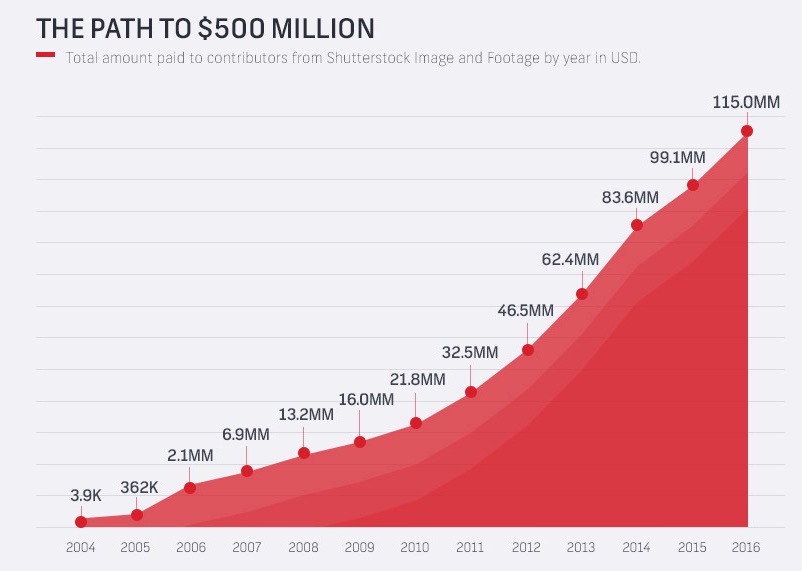Thinking about turning your photography hobby into a side hustle? Shutterstock is one of the biggest platforms out there for photographers to monetize their images. Whether you’re a seasoned pro or just starting out, you might be wondering: how much money can you really make selling photos on Shutterstock? The good news is, it’s possible to earn a decent income, but it depends on a few key factors. In this post, we’ll dive into how the platform works and what you can expect to earn as a contributor. Let’s get started and see if
Understanding Shutterstock’s Revenue Model for Photographers

Shutterstock operates on a straightforward yet rewarding revenue system for photographers who upload and sell their images. When you submit your photos to Shutterstock, they become available for purchase by millions of buyers worldwide—ranging from small businesses to large corporations, and even individual consumers. Every time someone downloads your photo, you earn a royalty.
How do royalties work? Essentially, your earnings depend on your contributor level and the type of license purchased. Shutterstock offers two main licensing options:
- Standard License: Suitable for most uses, like websites, marketing materials, and social media. Royalties are generally lower here.
- Enhanced License: For high-end commercial uses, such as billboards or large print runs, offering higher payouts.
Your payout per download varies based on your contributor level, which is determined by your total lifetime earnings. The higher your level, the higher your royalty rate. For example, beginners might earn around 20-30% of the licensing fee, but top contributors can earn over 60%. Here’s a quick look at how your contributor level influences your earnings:
| Contributor Level | Total Earnings | Royalty Rate | Estimated Earnings per Download |
|---|---|---|---|
| Contributor | $0 – $500 | 20% | $0.20 – $0.50 |
| Contributor Plus | $500 – $3,000 | 30% | $0.60 – $1.50 |
| Elite Contributor | $3,000+ | 60% | $1.20+ |
So, how much money can you make? Well, it really depends on how many images you upload, how popular they become, and your level as a contributor. Some photographers earn just a few dollars a month, while others make a full-time income. The key is consistently uploading high-quality, in-demand images and understanding the platform’s licensing structure. With patience and strategic uploads, earning a significant side income—or even a living—is definitely within reach!
Factors Influencing Your Earnings on Shutterstock

When it comes to earning money through Shutterstock, there’s no one-size-fits-all answer. Your income can vary widely depending on several key factors. Understanding these can help you strategize better and maximize your earning potential.
First and foremost, the quality of your photos plays a huge role. High-resolution, well-composed, and visually appealing images tend to sell more. Shutterstock and its customers are drawn to professional-looking photos that meet current trends and standards. So, investing time in learning photography techniques and editing can really pay off.
Next, the quantity of your submissions matters. The more quality images you upload, the higher your chances of making sales. Think of it like building a portfolio—more options for buyers mean more opportunities to earn. However, don’t sacrifice quality for quantity; it’s better to have fewer stunning images than many mediocre ones.
Another critical factor is keywording and metadata. Properly tagging your images with relevant keywords makes it easier for buyers to find your photos. Use specific and descriptive keywords rather than vague terms. For example, instead of just “dog,” try “golden retriever puppy playing fetch in park.” Well-optimized images are more likely to be discovered and purchased.
Niche topics can also influence earnings. Specialized images in high-demand categories such as business, healthcare, technology, or seasonal themes often fetch higher commissions. Consider researching trending topics or gaps in the Shutterstock library and creating images that fill those needs.
Finally, your contribution level and licensing choices impact earnings. Shutterstock offers different contributor levels based on your sales performance, which can offer perks like higher download rates. Additionally, choosing exclusive licensing options can potentially earn you more per sale, but it limits where else you can sell those images.
In summary, your earnings are shaped by a mix of image quality, volume, keywording, niche focus, and licensing decisions. By honing these elements, you can boost your sales and overall income on Shutterstock.
Average Earnings of Shutterstock Contributors

So, what can you really expect to earn as a Shutterstock contributor? The truth is, earnings vary quite a bit, but understanding the averages can give you a better idea of the potential.
On average, new contributors typically earn around $0.25 to $0.50 per download. This rate can increase as you become more experienced and achieve higher contributor levels. Once you hit higher tiers, your per-download earnings can go up to around $0.75 to $1.00 or more.
Many contributors report earning anywhere from a few dollars to several hundred dollars per month. It often depends on the number of downloads your images receive. For example:
- Beginner contributors: Might earn $10–$50 per month with a small portfolio.
- Intermediate contributors: With more images and better visibility, earnings can range from $100–$500 per month.
- Top contributors: Those with extensive portfolios and high-quality images can make $1,000 or more per month or even significantly more.
It’s important to remember that building a profitable portfolio takes time. Consistent uploading, keyword optimization, and staying current with trends can help accelerate your earnings. Also, some contributors diversify their income by selling on multiple stock platforms, which can further increase their total revenue.
While Shutterstock isn’t a get-rich-quick scheme, many photographers and designers find it to be a steady source of passive income over time. The key is patience, persistence, and continuously improving your craft and metadata strategies.
In essence, your earnings will depend on your effort, the quality of your images, and how well you understand the marketplace. Keep creating, learning, and adapting, and over time, your Shutterstock income can grow into a rewarding side hustle or even a full-time gig.
Tips to Maximize Your Income from Selling Photos
So, you’re ready to turn your photography hobby into a steady income stream on Shutterstock. That’s awesome! But how do you make sure your photos stand out and earn you the most money? Here are some practical tips to help you maximize your earnings:
Focus on Popular and Trending Topics
Shutterstock buyers often search for images related to current trends, seasonal events, and evergreen topics. Keep an eye on trending keywords, seasonal holidays, and popular themes like health, technology, or business. By submitting photos that match what people are actively searching for, you increase your chances of making sales.
Invest in Quality and Composition
High-quality, well-composed images tend to sell better. Make sure your photos are sharp, well-lit, and properly exposed. Use a good camera and editing software to enhance your images, but avoid over-editing. Remember, clarity and professionalism matter — they can make a huge difference in attracting buyers.
Use Relevant and Specific Keywords
When uploading your photos, don’t forget to add detailed and accurate keywords. Think about what someone might search for if they want to find your image. Use a mix of broad and niche keywords. The more precise your tags, the easier it is for buyers to discover your work.
Upload Consistently and Build a Portfolio
Regular uploads help keep your portfolio active and increase your chances of being featured or recommended. Aim to upload new photos weekly or bi-weekly. Over time, a diverse and sizable portfolio can attract more buyers and increase your overall earnings.
Leverage Collections and Curate Your Best Work
Create collections or themed galleries to showcase your best images. This not only makes your portfolio more organized but also encourages buyers to browse more of your work. Curating your collection with your strongest images can lead to higher sales and better visibility.
Stay Informed and Adapt
Market trends change, so stay updated with what’s popular on Shutterstock and in the stock photo industry. Join online forums, read industry blogs, and follow Shutterstock’s updates. Adapting your content strategy based on market demands can significantly boost your earning potential.
Common Challenges and How to Overcome Them
While selling photos on Shutterstock can be rewarding, it’s not without its hurdles. Knowing what challenges you might face and how to tackle them can save you frustration and help you succeed faster.
Challenge: Finding Your Niche
With millions of images on Shutterstock, standing out can be tough. Some photographers struggle to find a unique style or niche that sets them apart. Solution: Experiment with different subjects and styles until you discover what resonates with buyers. Focus on a niche you’re passionate about, whether it’s food photography, travel, or lifestyle shots.
Challenge: Low Sales and Income Variability
Initial sales might be slow, and income can fluctuate month to month. It’s common for new contributors to see little income at first. Solution: Be patient and consistent. Keep uploading quality images regularly, optimize your keywords, and diversify your portfolio. Over time, your sales should grow as your portfolio gains traction.
Challenge: Copyright and Licensing Concerns
Ensuring your images are compliant with Shutterstock’s licensing rules and avoiding copyright infringement can be tricky. Solution: Only upload images you own or have rights to, and be cautious with recognizable people or trademarks. Use model releases when necessary and familiarize yourself with Shutterstock’s content guidelines.
Challenge: Standing Out in a Crowded Marketplace
With so many contributors, getting your images noticed can be challenging. Solution: Invest in high-quality, unique photos, use effective keywords, and promote your portfolio on social media or photography communities. Building a personal brand can also help attract more buyers.
Challenge: Staying Motivated and Consistent
It’s easy to feel discouraged if sales are slow or if you face rejection. Solution: Set realistic goals, celebrate small wins, and remember why you started. Keep learning, stay inspired, and treat your Shutterstock journey as a long-term project. Persistence is key!
Final Thoughts on Earning Potential with Shutterstock Photography
When considering the potential earnings from selling photos on Shutterstock, it’s important to understand the various factors that influence your income. Your earnings largely depend on the quality and uniqueness of your images, the volume of photos you upload, and how well you optimize your portfolio for search. Shutterstock offers a royalty-based model, with contributors earning a percentage of each sale, typically ranging from 15% to 40% depending on your exclusive or non-exclusive status. Top contributors can generate significant passive income, but success requires consistency, high-quality work, and strategic keywording.
Some key points to keep in mind include:
- Royalty Rates: They fluctuate based on your contributor level and sales volume.
- Sales Volume: The more images you upload and optimize, the higher your chances of earning more.
- Image Quality & Niche: Unique and high-demand images tend to sell better.
- Marketing & SEO: Proper keywording and categorization enhance discoverability.
While many contributors earn a modest supplemental income, some top performers generate thousands of dollars per month. It’s important to set realistic expectations and view Shutterstock as a platform for passive income rather than a quick path to riches. Success hinges on dedication, continuous improvement, and understanding market trends.
In conclusion, earning potential on Shutterstock varies widely, but with effort and strategic approach, it can become a valuable part of your income stream.


